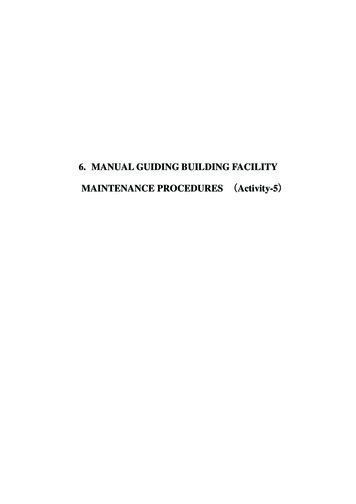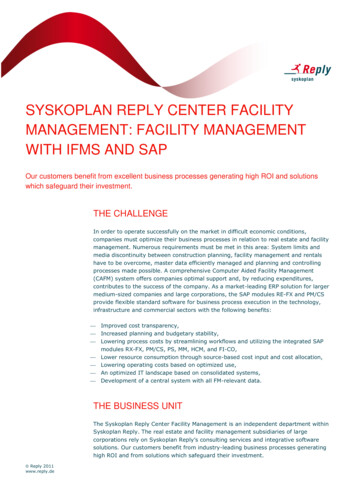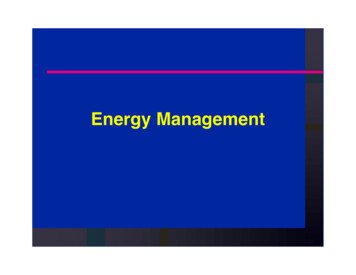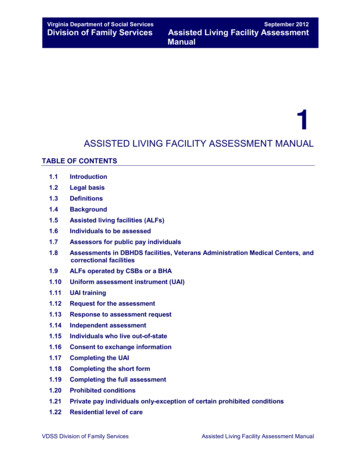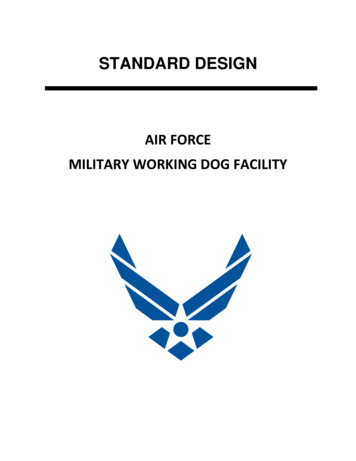
Transcription
FacilityMaintenanceManagementQualification StandardReference GuideNOVEMBER 2009
Table of ContentsFIGURES. ivTABLES. ivACRONYMS . vPURPOSE. 1SCOPE . 1PREFACE. 1TECHNICAL COMPETENCIES. 31. Facility maintenance management personnel shall demonstrate a working-level knowledge ofthe guidelines for maintaining maintenance facilities, equipment, and tools. . 32. Facility maintenance management personnel shall demonstrate a working-level knowledge ofthe application of the different types of maintenance. 93. Facility maintenance management personnel shall demonstrate a working-level knowledge ofthe documentation used for controlling maintenance. . 134. Facility maintenance management personnel shall demonstrate a working-level knowledge ofthe requirements for controlling maintenance activities. 165. Facility maintenance management personnel shall demonstrate a working-level knowledge ofplanning, scheduling, and coordination of maintenance activities. . 246. Facility maintenance management personnel shall demonstrate a working-level knowledge ofindustrial property management practices as related to stores, spare parts, and essentialmaterials. 317. Facility maintenance management personnel shall demonstrate a working-level knowledge ofthe control and calibration of measuring and test equipment. . 358. Facility maintenance management personnel shall demonstrate a working-level knowledge ofmodification work. 409. Facility maintenance management personnel shall demonstrate a working-level knowledge ofthe requirements of post-maintenance testing. 4310. Facility maintenance management personnel shall demonstrate a working-level knowledge ofthe requirements for material receipt, inspection, handling, storage, retrieval, and issuance. 4511. Facility maintenance management personnel shall demonstrate a working-level knowledge ofthe requirements of maintenance tools and equipment control. . 5012. Facility maintenance management personnel shall demonstrate a working-level knowledge ofthe requirements for facility condition inspections. 5113. Facility maintenance management personnel shall demonstrate a working-level knowledge ofthe requirements for management involvement. 5414. Facility maintenance management personnel shall demonstrate a working-level knowledge ofthe requirements of maintenance history and configuration control. . 5615. Facility maintenance management personnel shall demonstrate a familiarity-level knowledgeof the principles and concepts of natural phenomena hazards and their effect on systems andstructures. . 58i
Table of Contents16. Facility maintenance management personnel shall demonstrate a working-level knowledge ofDOE’s requirements for facility maintenance management as outlined in DOE O 433.1,Maintenance Management Program for DOE Nuclear Facilities. . 7617. Facility maintenance management personnel shall demonstrate a familiarity-level knowledgeof the requirements for a training and qualification program as identified in the followingDepartment of Energy (DOE) Orders:. 8118. Facility maintenance management personnel shall demonstrate a familiarity-level knowledgeof the facility maintenance management-related sections and/or requirements of thefollowing related DOE Orders:. 8819. Facility maintenance management personnel shall demonstrate a working-level knowledge ofthe following maintenance management-related Department of Energy Technical Standardand Maintenance Management Program Guide:. 9120. Facility maintenance management personnel shall demonstrate a familiarity-level knowledgeof DOE Order 231.1A, Environment, Safety, and Health Reporting. . 9221. Facility maintenance management personnel shall demonstrate a familiarity-level knowledgeof DOE Order 414.1C Chg 1, as it pertains to facility maintenance. . 9422. Facility maintenance management personnel shall demonstrate a familiarity-level knowledgeof 10 CFR 830.203, Unreviewed Safety Question Process. . 9623. Facility maintenance management personnel shall demonstrate a familiarity-level knowledgeof the TSRs as described in 10 CFR 830.205, Technical Safety Requirements. 9924. Facility maintenance management personnel shall demonstrate a familiarity-level knowledgeof nuclear safety analysis reports as described in 10 CFR 830.204, Documented SafetyAnalysis Reports. . 10225. Facility maintenance management personnel shall demonstrate a familiarity-level knowledgeof DOE -STD-1073-93, Configuration Management. . 10726. Facility maintenance management personnel shall demonstrate a familiarity-level knowledgeof DOE O 413.3, Program and Project Management for the Acquisition of Capital Assets.11427. Facility maintenance management personnel shall demonstrate a familiarity-level knowledgeof the following DOE technical standards and Order related to natural phenomena hazards:12028. Facility maintenance management personnel shall demonstrate a familiarity-level knowledgeof methods to maintain communication with Headquarters, field elements, and the public.12129. Facility maintenance management personnel shall demonstrate a familiarity-level knowledgeof facility maintenance management-related data management requirements. . 12530. Facility maintenance management personnel shall demonstrate a working-level knowledge ofcontractor and Department organization and structure as they relate to maintenancemanagement responsibilities and authority. 12731. Facility maintenance management personnel shall demonstrate a working-level knowledge ofassessment techniques (such as the planning and use of observations, interviews, anddocument reviews) to assess facility performance, report results of assessments, and followup on actions taken as the result of assessments. 130ii
Table of Contents32. Facility maintenance management personnel shall demonstrate a working-level knowledge oflessons learned and problems impacting the Department’s maintenance activities across thecomplex. 13433. Facility maintenance management personnel shall demonstrate a working-level knowledge ofthe requirements of a maintenance management program. . 13834. Facility maintenance management personnel shall demonstrate the ability to conductindependent assessments of a contractor’s compliance with the requirements of DOE O433.1, Maintenance Management Program for DOE Nuclear Facilities. . 14135. Facility maintenance management personnel shall demonstrate a working-level knowledge ofproblem analysis principles and techniques necessary to identify maintenance problems,determine potential causes of problems, and identify corrective action(s). 14236. Facility maintenance management personnel shall demonstrate the ability to apply problemanalysis techniques necessary to identify maintenance problems, determine potential causes,and identify corrective action(s). . 14737. Facility maintenance management personnel shall demonstrate the ability to trend facilitymaintenance management-related data. . 14738. Facility maintenance management personnel shall demonstrate a familiarity-level knowledgeof financial management practices and the application of contractor resources to meetcommitments to the quality, safety, cost, and schedule of systems. 14839. Facility maintenance management personnel shall demonstrate the ability to perform projectmanagement duties as required to provide facility maintenance management technicalsupport to a project. 15340. Facility maintenance management personnel shall demonstrate a familiarity-level knowledgeof the DOE project management system, including the application of contractor resources tomeet commitments to quality, safety, cost, and schedule. . 15341. Facility maintenance management personnel shall demonstrate a familiarity-level knowledgeof the DOE/facility contract provisions necessary to provide oversight of a contractor’sperformance. . 16342. Facility maintenance management personnel shall demonstrate the ability to conductindependent assessments of the contractor’s maintenance training and qualificationprogram(s) in accordance with DOE Order 433.1, Maintenance Management Program forDOE Nuclear Facilities, and DOE Order 5480.20A, Personnel Selection, Qualification, andTraining Requirements for DOE Nuclear Facilities. . 166Selected Bibliography and Suggested Reading . 167iii
Table of ContentsFIGURESFigure 1. Flood evaluation process . 60Figure 2. Combined probabilistic and deterministic methods to achieve performance goals . 72Figure 3. Configuration management interfaces. 110Figure 4. Typical DOE acquisition management system. 119Figure 5. DOE corporate operating experience approach. 135Figure 6. DOE lessons learned flow . 137TABLESTable 1. Summary of minimum wind design criteria. 63Table 2. Recommended peak gust wind speeds for straight winds and tornadoes . 64Table 3. Recommended missile barriers for performance category 3. 68Table 4. Critical decision authority thresholds. 118Table 5. DOE project lifecycle phases . 162iv
dministrative controlsactual cost of work performedas low as reasonably achievableatmospheric pressure changebudgeted cost of work performedbudgeted cost of work scheduledcritical decisionconfiguration managementdesign basis floodU.S. Department of Energydocumented safety analysisestimate at completionU.S. Environmental Protection Agencyenvironment, safety, and healthearned valueearned value management systemFunctional Area Qualification Standardfire hazard analysisgovernment-owned, contractor-operatedIntegrated Safety Management Systemkey performance parameterknowledge, skill, and abilitylimiting condition for operationlimiting control settingmanagement and operatingmeasuring and test equipmentmaster equipment listmaintenance implementation planmaximum possible fire lossmiles per hourNational Institute of Standards and TechnologyNational Nuclear Security Administrationnatural phenomena hazardon-the-job trainingoperating limitsOffice of Management and Budgetother project costperformance categorypreliminary documented safety analysispreventive maintenancepost-maintenance tests/testingquality assurancequality assurance programquality controlv
feit itemsafety analysis reportsafety limitsurveillance requirementsstructure, system, or componenttotal estimated costtotal project costtechnical safety requirementsunreviewed safety questionwork breakdown structurework orderwork requestvi
PURPOSEThe purpose of this reference guide is to provide a document that contains the informationrequired for a Department of Energy (DOE)/National Nuclear Security Administration (NNSA)technical employee to successfully complete the Environmental Compliance Functional AreaQualification Standard (FAQS). Information essential to meeting the qualification requirementsis provided; however, some competency statements require extensive knowledge or skilldevelopment. Reproducing all the required information for those statements in this document isnot practical. In those instances, references are included to guide the candidate to additionalresources.SCOPEThis reference guide addresses the competency statements in the March 2004 edition ofDOE-STD-1181-2004, Facility Maintenance Management Functional Area QualificationStandard. The qualification standard contains 42 competency statements.Please direct your questions or comments related to this document to the NNSA Learning andCareer Development Department.PREFACECompetency statements and supporting knowledge and/or skill statements from the qualificationstandard are shown in contrasting bold type, while the corresponding information associated witheach statement is provided below it.A comprehensive list of acronyms and abbreviations is found at the beginning of this document.It is recommended that the candidate review the list prior to proceeding with the competencies,as the acronyms and abbreviations may not be further defined within the text unless specialemphasis is required.The competencies and supporting knowledge, skill, and ability (KSA) statements are takendirectly from the FAQS. Most corrections to spelling, punctuation, and grammar have been madewithout remark, and all document-related titles, which variously appear in roman or italic type orset within quotation marks, have been changed to plain text, also mostly without remark.Capitalized terms are found as such in the qualification standard and remain so in this referenceguide. When they are needed for clarification, explanations are enclosed in brackets.Every effort has been made to provide the most current information and references available asof November 2009. However, the candidate is advised to verify the applicability of theinformation provided. It is recognized that some personnel may oversee facilities that utilizepredecessor documents to those identified. In those cases, such documents should be included inlocal qualification standards via the Technical Qualification Program.In the cases where information about a FAQS topic in a competency or KSA statement is notavailable in the newest edition of a standard (consensus or industry), an older version isreferenced. These references are noted in the text and in the bibliography.1
Only significant corrections to errors in the technical content of the discussion text sourcematerial are identified. Editorial changes that do not affect the technical content (e.g.,grammatical or spelling corrections, and changes to style) appear without remark.2
TECHNICAL COMPETENCIES1. Facility maintenance management personnel shall demonstrate a working-levelknowledge of the guidelines for maintaining maintenance facilities, equipment, andtools.a. Discuss the importance of maintaining proper maintenance facilities.The following is taken from DOE G 433.1-1.Management involvement in control of maintenance activities should ensure thatmaintenance practices are effective in maintaining safe and reliable facility operation. Thiscontrol should extend to all facility, contractor, and subcontractor personnel involved inmaintenance activities. Rigorous control of maintenance activities should be directed towardachieving high-quality work performance, personnel safety (including radiologicalprotection), equipment and system protection, and facility safety and reliability.b. Describe the criteria used when designing the layout of a shop or satellite workarea.The following is taken from DOE G 433.1-1.The layout of shop and satellite work areas should be designed with a high priority onindustrial safety and efficiency. As shops are modified and satellite work areas are changedthroughout the life of the facility, safety and efficiency should remain foremostconsiderations. Location and type of work performed should be considered in determiningthe types and level of environmental controls and services to be included in eachmaintenance shop and satellite work area. Examples of some environmental controls andservices include the following: fume removal; temperature, humidity, and dust control; equipment space considerations; lighting; demineralized water; noise control; facility service and instrument air; electric power supplies; radiological controls.Environmental conditions often have a significant impact on personnel performance.Supervisors need to be responsive to maintaining workplace environmental controlsconducive to increased maintenance quality and work efficiency. Each shop and satellitework area should have storage that is convenient and that encourages craft personnel to keepthe area neat and clean. Shelves, cabinets, lockers, and toolboxes are examples of storagefacilities that could be provided for items such as tools, parts, reference materials, andpersonal effects.3
c. Discuss when temporary facilities are used, the factors to consider whenapproving, purchasing, designing, and locating temporary facilities.The following is taken from DOE G 433.1-1.Temporary facilities are required for activities involving contractor support during outagesand control of airborne radioactivity and contamination. Planning and coordinatingtemporary facilities with other groups, such as radiological protection and operations, resultin more efficient use of space. Such necessary services as electric power, compressed air,water, environmental controls, and lighting should be provided at temporary-outage supportfacilities. Maintaining radiation exposure as low as reasonably achievable (ALARA) shouldbe considered when designing and locating temporary facilities. Glove boxes or temporarycontainments should be considered for work on contaminated equipment to prevent spread ofcontamination. Design of major temporary facilities should be controlled through the plant’sdesign change programs to ensure that additional building services (such as electricity,compressed air, and water) do not overload plant systems.d. Discuss the reasons for segregating tools, supplies, and parts.The following is taken from DOE G 433.1-1.The following practices should be utilized for storage and handling of tools, supplies andparts: Facilities should be provided for segregation, calibration, and repair of maintenanceand test equipment; Contaminated tools are segregated from clean tools to prevent cross-contamination; Parts and material required for maintenance activities should be identified andpurchased in time to allow for receipt and inspection well before they are needed.After processing, these parts and material should be identified for specific workpackages and segregated from other stock inventory; Adequate storage and protection of parts and materials segregated for plannedmaintenance activities should be provided. This is particularly important for materialstaged at the job site and not within normal storage areas; Controls should be developed and maintained throughout the procurement process tohelp obtain parts, materials, and services promptly. Nonconforming items should beclearly identified and segregated from normal items to prevent inadvertent use; Items receiving special inspection [especially safety-class items and safety-significantstructures, systems, or components (SSCs)] should be appropriately identified andsegregated from normal stock to indicate status and ensure proper application; Safety material and equipment should be segregated from non-safety-related materialand equipment to prevent inadvertent use of the wrong category of item. Ifsegregation is not practical, marking and tagging techniques should be developed topreclude use of the wrong material or equipment; A system should be established to ensure the proper storage, segregation, and controlof hazardous materials such as chemicals, radioactive/reactive organics, reagents,explosives, flammables/combustibles, corrosives, and pesticides/herbicides; specialtyequipment and tools; and general materials, equipment, and tools.4
Worn, defective, or otherwise unusable tools should be segregated so that only safe,usable tools are available. Unrepairable tools should be disposed of in a timelymanner.e. Discuss the use of contaminated tools versus clean tools.The following is taken from DOE G 433.1-1.An adequate supply of tools and equipment dedicated for exclusive use in radiological areasshould minimize the number of unnecessarily contaminated tools used to perform workwithin the radiological area. The control of these tools, including issuance, decontamination,inventory, and repair, should be assigned to a single facility department manager. Asufficient supply of radiological area tools and equipment should be established for routinemaintenance needs to prevent introduction of additional non-contaminated items. The inputand the cooperation of all maintenance work groups are required during maintenanceplanning to determine the types and numbers of tools and equipment needed. Input should beobtained from maintenance, operations, planning, engineering, radiological protection, andcontractor groups.f.Discuss the concerns affecting the selection and state of readiness ofmaintenance facilities.The following is taken from DOE G 433.1-1.Maintenance facilities, equipment, and tools should efficiently support the facilitymaintenance and maintenance training functions. Maintenance facilities directly affect thetraining of maintenance personnel and the ability to maintain the facility in an optimum stateof readiness.Evaluation of the adequacy of maintenance facilities is needed to help ensure thatmaintenance activities can be effectively accomplished. Industrial safety, location, access,communication, environmental controls, radiological controls, power sources, and the type ofactivity to be performed are examples of items to be considered in providing adequatemaintenance facilities. Maintenance training facilities, shops, satellite work areas, laydownand staging areas, storage facilities, mockups, temporary facilities, decontamination facilities,shower and toilet facilities, lunch areas, conference areas, and offices are examples ofmaintenance facilities that need evaluation. In addition, adequate office equipment should beprovided to support efficient and effective work. The objective is to create and maintain asafe and productive workplace where high-quality work can be performed.g. Describe the objective of maintenance facilities.Maintenance goals should be used as a management tool for involving cognizant facility groupsin improving maintenance performance and for measuring maintenance effectiveness.Maintenance goals such as the following should be established: reduce the impact of planned outages by planning and completing maintenanceactivities promptly; reduce the number of unplanned outages; minimize unplanned challenges to safety systems;5
reduce the lost-time accident rate;reduce station and equipment downtime;reduce personnel errors;reduce radiological exposure;control and reduce contaminated areas;reduce repeat maintenance work requests (WRs) (rework);complete scheduled surveillance and PM activities promptly;manage the corrective maintenance backlog to minimize it and the completion time ofresolving outstanding deficiencies;control overtime;staff and train the maintenance organization; andcomplete outage and no outage work on schedule.h. Describe the types and levels of environmental controls and services included inshops and satellite work areas.See item b of competency 1.i.Discuss the elements to consider when planning for the identification and use ofmaintenance lay down and staging areas.The following is taken from DOE G 433.1-1.A plan for identification and use of maintenance laydown and staging areas should bedeveloped and kept current. This plan should define outage support requirements, use, andresponsibility for area upkeep and control and should include items such as the following: authorization for access, with provisions for security and fire protection; radiological control; labeling of facilities to designate responsibility and entry authorization; contingency plans for situations (such as unanticipated radioactive airbornecontamination) that could render a facility unusable for its intended purpose.j.Discuss the issues addressed when determining storage facility needs.The following is taken from DOE G 433.1-1.Storage facilities for supplies and parts are an important consideration in providing for safe,efficient, and high-quality maintenance. The evaluation performed to determine storagefacility needs should address items such as the following: environmental controls, considering such issues as isolation/segregation of chemicals,flammability of lubricants and paint, qualification of parts/components, damage toelastomers and polypropylene parts because of exposure to light, and control ofradioactive materials; storage activity controls, considering such subjects as material receipt, inspection,handling, storage, retrieval, and issuance, and tool and equipment control; inventory level of spare parts, supplies, and equipment to support safe and reliableoperation of the facility.6
k. Discuss the requirements for storing, issuing, and maintenance of tools andequipment.The following is taken from DOE G 433.1-1.Storage facilities should be central to shops and normal work areas to improve maintenanceefficiency. They should store tools and equipment needed daily by craft personnel; specialtools, special equipment and test rigs; and mockups; all should be readily retrievable whenneeded. These facilities should have controls for temperature, humidity, dust, and radioactivecontamination, as needed. They should also meet manufacturers’ special material handling orstorage requirements. Facilities should be provided for segregation, calibration, and repair ofmaintenance and test equipment. Design considerations such as heavy loads and seismiccriteria should be considered for in-plant storage areas for tools.The maintenance organization should assign responsibility for the proper storage andissuance of both stationary and portable tools and equipment. Permanent issuance of tools toindividuals or groups of crafts persons who use them daily and who are responsible formaintaining them contributes to worker efficiency. Tools and equipment used less oftenshould be available on an as-needed basis. Controls, such as sign-out sheets and tool cribattendants, should be used in tool storage areas to provide accountability for, and availabilityof tools. A policy should be established for the storage, issuance, decontamination, and reuseof contaminated tools and equipment.An inventory system should be established for tools and equipment. This inventory should becomputer-based, compatible with existing facility inventory
21. Facility maintenance management personnel shall demonstrate a familiarity-level knowledge of DOE Order 414.1C Chg 1, as it pertains to facility maintenance. . 94 22. Facility maintenance management personnel shall demonstrate a familiarity-level knowledge
